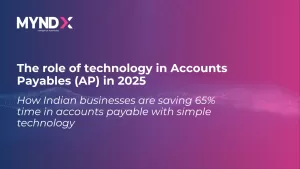MYND Integrated Solutions - Blog
Where Back-Office Wisdom Meets Tomorrow’s Tech
Stay Ahead with Actionable Intelligence
Let’s face it – in finance, HR, and automation, what you know determines how far you grow. Dive into practical guides, trend analyses, and insider perspectives to turn back-office operations into your clients’ superpower.
Featured Blogs
Multi-Country Payroll Outsourcing: A Strategic Guide for Global HR Leaders
A MYND Integrated Solutions Whitepaper Empowering HR Leaders to Transform Global Payroll Operations Executive Summary Managing payroll across multiple countries...
Read MoreThe role of technology in Accounts Payables (AP) in 2025
Your vendors are calling 10 times to inquire about payment status. Your accountant is matching bills till 9 PM. This...
Read MoreHow Smart AP Management Becomes Your Working Capital Lifeline
A 5-minute read on why your accounts payable function might be the unsung hero of financial resilience. Remember the last...
Read MorePetty Cash Management in 2024
As we step into the year 2024, the landscape of financial management continues to evolve, with businesses embracing cutting-edge technologies...
Read MoreNavigating the Complexities of Modern Payroll Systems
Navigating the intricate web of modern payroll systems is akin to embarking on a grand expedition through a vast and...
Read MoreTransforming Human Resources Management in the Digital Age
In the fast-evolving landscape of the digital age, the role of Human Resources (HR) management is undergoing a profound transformation....
Read MoreRevolutionizing Accounts Payable with Mynd Accounts Payable Automation (MyndAPX): Strategies for Efficiency and Accuracy
In the fast-paced realm of business, managing accounts payable efficiently stands as a crucial aspect of maintaining financial health and...
Read MoreThe Impact of Digitalization on Traditional Business Processes: A MYND Perspective
Digitalization has emerged as a game-changer for businesses of all sizes and industries in the past few years. With the...
Read MoreMyndHRX: Building a Resilient and Adaptable Workforce
In today’s dynamic and ever-changing business landscape, organizations must prioritize building a resilient and adaptable workforce to thrive and succeed....
Read MoreThe Benefits of Integrated Financial and HR Services for SMEs
In the competitive arena of SMEs, aligning financial management with human resources is not just an aim but a crucial...
Read MoreMyndLeaseX: Simplifying Lease Accounting for Modern Businesses
Navigating the complexities of lease accounting in today’s financial landscape poses a significant challenge for businesses. MyndLeaseX stands out as...
Read MoreMyndSpendX: Transforming Branch Cash Management through Automation
In today’s fast-paced business environment, managing branch cash efficiently is paramount. MyndSpendX offers a revolutionary automated solution that transforms traditional...
Read MoreExplore by Category

Finance & Accounting
- AP automation hacks
- IFRS updates
- Cash flow optimization

HR & Workforce
- Multi-country payroll pitfalls Gig economy compliance
- Employee experience trends

Tech & Automation
- AI use cases
- RPA implementation guides
- Legacy system migration

Industry Insights
- Retail
- Manufacturing
- Healthcare
- BFSI
Never Miss an Update
Get our best insights first
We promise: No spam, just actionable intel. Unsubscribe anytime.
Why Our Readers Stay Hooked

No Fluff Policy
Only data-backed, field-tested advice

Global Lens
Perspectives that apply globally

Tech Meets Reality
What works (and what’s hype) in AI/automation











